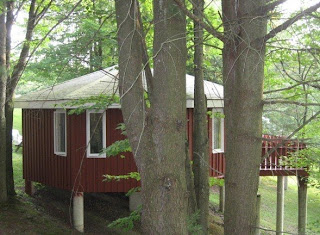The most important first was that it was a rite of passage of sorts for KJ, her introduction to this unique aspect of my world. While not her first trip to Cooperstown, of course, it was her first experience with this particular custom.
The drive to New York State's Central Leatherstocking Region was fairly uneventful, except for KJ's observation that many towns in upstate New York end in the suffix -kill. First and foremost, there's my native Peekskill, as well as Poughkeepsie's neighbor, Fishkill. Add to that Catskill, Cobleskill, Plattekill, Wallkill and Wyantskill—just to name a few—and you've got yourself quite a trend. We pondered what exactly kill, in this context, means. We assumed, of course, that it has some geographic meaning, and it turned out to be much more obvious than either of us imagined. A kill is a creek, and according to Webster, it's most commonly used as a place name in the states of Delaware, Pennsylvania and New York.
Our accommodations for the weekend were another first. After returning to the same campground for more than 10 consecutive years, last year we finally decided we needed to stay somewhere new. I won't go into detail, but let's just say that the conditions at said campground had gradually been deteriorating in recent years. If you've been a regular reader of this blog for more than a year, you already know that last year's effort to find a new place to stay was mostly unsuccessful. So, we tried a new location once again, this one about 12 miles from 25 Main Street in Cooperstown, the location of the Hall of Fame.

KJ and I rented a cottage at the Belvedere Lake Campground in nearby Cherry Valley...or Roseboom, I'm not exactly sure which town it's in. The place was over-priced, but so is everything in and around Cooperstown this particular weekend. So, relatively speaking, it was worth every penny. It was charming, scenic and fairly quiet. It was also an easy drive into town on bucolic country roads. The only odd thing about it was that they gave us tokens to get through the gate each time we entered the campground. We gave one of these to the Williamses when we invited them out to barbecue with us on Saturday night. Then, we read the rules regarding guests, and we were supposed to pay an extra $20—five dollars for each person over 12—for the four of them to visit. We didn't.
Saturday was a day for revisiting the mini-traditions that go hand-in-hand with the larger one. Our first stop upon arriving in town was Cooley's, the local tavern that's become our afternoon hangout. A couple rounds of beers and a few dozen wings later, and we were off to the annual minor league contest played at cozy Doubleday Field. We toyed with the idea of doing our first shotski—four shots lined up on a wooden ski that need to be consumed by four people simultaneously—but never pulled the trigger. Maybe next year we will.
The minor league game was between the Oneonta Tigers and the Tri-City Valley Cats, both of the Class A New York-Penn League. For some reason, this game never seems to be particularly interesting. Maybe it's because there is so much else going on in town and we have other things on our minds. As usual, we stuck around for a few innings and then moved on, choosing to brave the crowds and attempt to do some shopping in town.

The most important tradition, of course, is setting up on the lawn of the Clark Sports Center while watching and listening to the weekend's main event, the Hall of Fame induction ceremony. This year's inductees included two candidates who didn't look like they would ever make it to Cooperstown and one player elected in his first year on the ballot.
Joe Gordon was elected posthumously by the Hall of Fame Veterans Committee, 31 years after he died of a heart attack in 1978. Gordon's daughter delivered his acceptance speech and did a nice job of honoring her father. She brought a tear to many an eye when she declared that—since her father's wish was not to be given a funeral—the family considered Cooperstown to be his final resting place.
In his speech, Jim Rice made it clear that—whether elected on the first ballot or the 15th—a Hall of Famer is a Hall of Famer. His was the least interesting of the three speeches—not surprising consider his lackluster performance as a NESN analyst—although he did earn a few laughs when he admitted that he was watching "The Young and the Restless" when he received the call from Hall of Fame President Jeff Idelson.
First ballot inductee Rickey Henderson delivered an uncharacteristically humble speech. He recalled an autograph seeking trip to Oakland Coliseum from his youth, when all he came away with was a pen with Reggie Jackson's name on it. Rickey also shared how much he truly misses Billy Martin, one of his first managers, and how he wished Billy could have been there on this special occasion. He ended his speech, referencing his own "I am the greatest" declaration following his breaking of Lou Brock's career stolen base mark, by saying "...at this moment, I am...very humbled."






